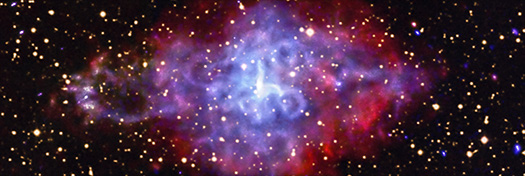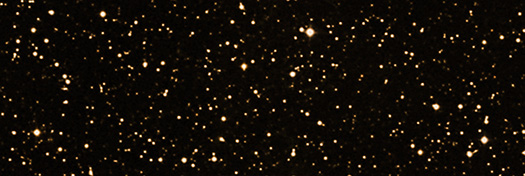
From The National Aeronautics and Space Administration Chandra X-ray telescope
6.20.24
Megan Watzke
Chandra X-ray Center, Cambridge, Massachusetts
617-496-7998
mwatzke@cfa.harvard.edu
Jonathan Deal
Marshall Space Flight Center, Huntsville, Alabama
256-544-0034
jonathan.e.deal@nasa.gov

Composite

X-ray

Optical
The supernova remnant 3C 58 contains a spinning neutron star, known as PSR J0205+6449, at its center. Astronomers studied this neutron star and others like it to probe the nature of matter inside these very dense objects. A new study, made using NASA’s Chandra X-ray Observatory and ESA’s XMM-Newton, reveals that the interiors of neutron stars may contain a type of ultra-dense matter not found anywhere else in the Universe, as reported in our latest press release.

___________________________
Neutron stars may contain a special type of ultra-dense matter that does not exist anywhere else in the universe.
A study using NASA’s Chandra and ESA’s XMM-Newton looked at data of many neutron stars, which are the dense cores of collapsed stars.
Three of these neutron stars are surprisingly cool, which gives clues about basic properties like the pressure and temperatures in their interiors.
The structure and properties of neutron stars might be crucial for interpreting the bursts of gravitational waves when they merge.
___________________________
In this image of 3C 58, low-energy X-rays are colored red, medium-energy X-rays are green, and the high-energy band of X-rays is shown in blue. The X-ray data have been combined with an optical image in yellow from the Digitized Sky Survey. The Chandra data show that the rapidly rotating neutron star (also known as a “pulsar”) at the center is surrounded by a torus of X-ray emission and a jet that extends for several light-years. The optical data shows stars in the field.
The team in this new study analyzed previously released data from neutron stars to determine the so-called equation of state.

This refers to the basic properties of the neutron stars including the pressures and temperatures in different parts of their interiors.
The authors used machine learning, a type of artificial intelligence, to compare the data to different equations of state. Their results imply that a significant fraction of the equations of state — the ones that do not include the capability for rapid cooling at higher masses — can be ruled out.
The researchers capitalized on some neutron stars in the study being located in supernova remnants, including 3C 58.

X-ray image of 3C 58 by the Chandra X-Ray Observatory. The pullout box shows the inner toroidal-shaped nebula.

Since astronomers have age estimates of the supernova remnants, they also have the ages of the neutron stars that were created during the explosions that created both the remnants and the neutron stars. The astronomers found that the neutron star in 3C 58 and two others were much cooler than the rest of the neutron stars in the study.
The team thinks that part of the explanation for the rapid cooling is that these neutron stars are more massive than most of the rest. Because more massive neutron stars have more particles, special processes that cause neutron stars to cool more rapidly might be triggered.
One possibility for what is inside these neutron stars is a type of radioactive decay near their centers where neutrinos — low mass particles that easily travel through matter — carry away much of the energy and heat, causing rapid cooling.
Another possibility is that there are types of exotic matter found in the centers of these more rapidly cooling neutron stars.
A Nature Astronomy paper describes these results. The authors of the paper are Alessio Marino (Institute of Space Sciences (ICE) in Barcelona, Spain), Clara Dehman (ICE), Konstantinos Kovlakas (ICE), Nanda Rea (ICE), J. A. Pons (University of Alicante in Spain), and Daniele Viganò (ICE).
Quick Look: NASA’s Chandra Peers Into Densest and Weirdest Stars
Visual Description:
This is an image of the leftovers from an exploded star called 3C 58, shown in X-ray and optical light. At the center of the remnant is a rapidly spinning neutron star, called a pulsar, that presents itself as a bright white object that’s somewhat elongated in shape.
Loops and swirls of material, in shades of blue and purple, extend outward from the neutron star in many directions, resembling the shape of an octopus and its arms.
Surrounding the octopus-like structure is a cloud of material in shades of red that is wider horizontally than it is vertically. A ribbon of purple material extends to the left edge of the red cloud, curling upward at its conclusion. Another purple ribbon extends to the right edge of the red cloud, though it is less defined than the one on the other side. Stars of many shapes and sizes dot the entire image.
See the full photo release article here.
See the full press release article here.
Comments are invited and will be appreciated, especially if the reader finds any errors which I can correct.

five-ways-keep-your-child-safe-school-shootings
Please help promote STEM in your local schools.
NASA’s Marshall Space Flight Center in Huntsville, Ala., manages the Chandra program for NASA’s Science Mission Directorate in Washington. The Smithsonian Astrophysical Observatory controls Chandra’s science and flight operations from Cambridge, Mass.
In 1976 the Chandra X-ray Observatory (called AXAF at the time) was proposed to National Aeronautics and Space Administration by Riccardo Giacconi and Harvey Tananbaum. Preliminary work began the following year at NASA’s Marshall Space Flight Center and the Harvard Smithsonian Center for Astrophysics. In the meantime, in 1978, NASA launched the first imaging X-ray telescope, Einstein (HEAO-2), into orbit. Work continued on the AXAF project throughout the 1980s and 1990s. In 1992, to reduce costs, the spacecraft was redesigned. Four of the twelve planned mirrors were eliminated, as were two of the six scientific instruments. AXAF’s planned orbit was changed to an elliptical one, reaching one third of the way to the Moon’s at its farthest point. This eliminated the possibility of improvement or repair by the space shuttle but put the observatory above the Earth’s radiation belts for most of its orbit. AXAF was assembled and tested by TRW (now Northrop Grumman Aerospace Systems) in Redondo Beach, California.
AXAF was renamed Chandra as part of a contest held by NASA in 1998, which drew more than 6,000 submissions worldwide. The contest winners, Jatila van der Veen and Tyrel Johnson (then a high school teacher and high school student, respectively), suggested the name in honor of Nobel Prize–winning Indian-American astrophysicist Subrahmanyan Chandrasekhar. He is known for his work in determining the maximum mass of white dwarf stars, leading to greater understanding of high energy astronomical phenomena such as neutron stars and black holes. Fittingly, the name Chandra means “moon” in Sanskrit.
Originally scheduled to be launched in December 1998, the spacecraft was delayed several months, eventually being launched on July 23, 1999, at 04:31 UTC by Space Shuttle Columbia during STS-93. Chandra was deployed from Columbia at 11:47 UTC. The Inertial Upper Stage’s first stage motor ignited at 12:48 UTC, and after burning for 125 seconds and separating, the second stage ignited at 12:51 UTC and burned for 117 seconds. At 22,753 kilograms (50,162 lb), it was the heaviest payload ever launched by the shuttle, a consequence of the two-stage Inertial Upper Stage booster rocket system needed to transport the spacecraft to its high orbit.
Chandra has been returning data since the month after it launched. It is operated by the SAO at the Chandra X-ray Center in Cambridge, Massachusetts, with assistance from Massachusetts Institute of Technology and Northrop Grumman Space Technology. The ACIS CCDs suffered particle damage during early radiation belt passages. To prevent further damage, the instrument is now removed from the telescope’s focal plane during passages.
Although Chandra was initially given an expected lifetime of 5 years, on September 4, 2001, NASA extended its lifetime to 10 years “based on the observatory’s outstanding results.” Physically Chandra could last much longer. A 2004 study performed at the Chandra X-ray Center indicated that the observatory could last at least 15 years.
In July 2008, the International X-ray Observatory, a joint project between European Space Agency [La Agencia Espacial Europea] [Agence spatiale européenne][Europäische Weltraumorganisation](EU), NASA and Japan Aerospace Exploration Agency (JAXA) (国立研究開発法人宇宙航空研究開発機構], was proposed as the next major X-ray observatory but was later cancelled. ESA later resurrected a downsized version of the project as the Advanced Telescope for High Energy Astrophysics (ATHENA), with a proposed launch in 2028.

On October 10, 2018, Chandra entered safe mode operations, due to a gyroscope glitch. NASA reported that all science instruments were safe. Within days, the 3-second error in data from one gyro was understood, and plans were made to return Chandra to full service. The gyroscope that experienced the glitch was placed in reserve and is otherwise healthy.
The National Aeronautics and Space Administration (NASA) is the agency of the United States government that is responsible for the nation’s civilian space program and for aeronautics and aerospace research.
President Dwight D. Eisenhower established the National Aeronautics and Space Administration (NASA) in 1958 with a distinctly civilian (rather than military) orientation encouraging peaceful applications in space science. The National Aeronautics and Space Act was passed on July 29, 1958, disestablishing NASA’s predecessor, the National Advisory Committee for Aeronautics (NACA). The new agency became operational on October 1, 1958.
Since that time, most U.S. space exploration efforts have been led by NASA, including the Apollo moon-landing missions, the Skylab space station, and later the Space Shuttle. Currently, NASA is supporting the International Space Station and is overseeing the development of the Orion Multi-Purpose Crew Vehicle and Commercial Crew vehicles. The agency is also responsible for the Launch Services Program (LSP) which provides oversight of launch operations and countdown management for unmanned NASA launches. Most recently, NASA announced a new Space Launch System that it said would take the agency’s astronauts farther into space than ever before and lay the cornerstone for future human space exploration efforts by the U.S.

NASA science is focused on better understanding Earth through the Earth Observing System, advancing heliophysics through the efforts of the Science Mission Directorate’s Heliophysics Research Program, exploring bodies throughout the Solar System with advanced robotic missions such as New Horizons, and researching astrophysics topics, such as the Big Bang, through the Great Observatories [NASA/ESA Hubble, NASA Chandra, NASA Spitzer, and associated programs.] NASA shares data with various national and international organizations such as from [JAXA]Greenhouse Gases Observing Satellite.





